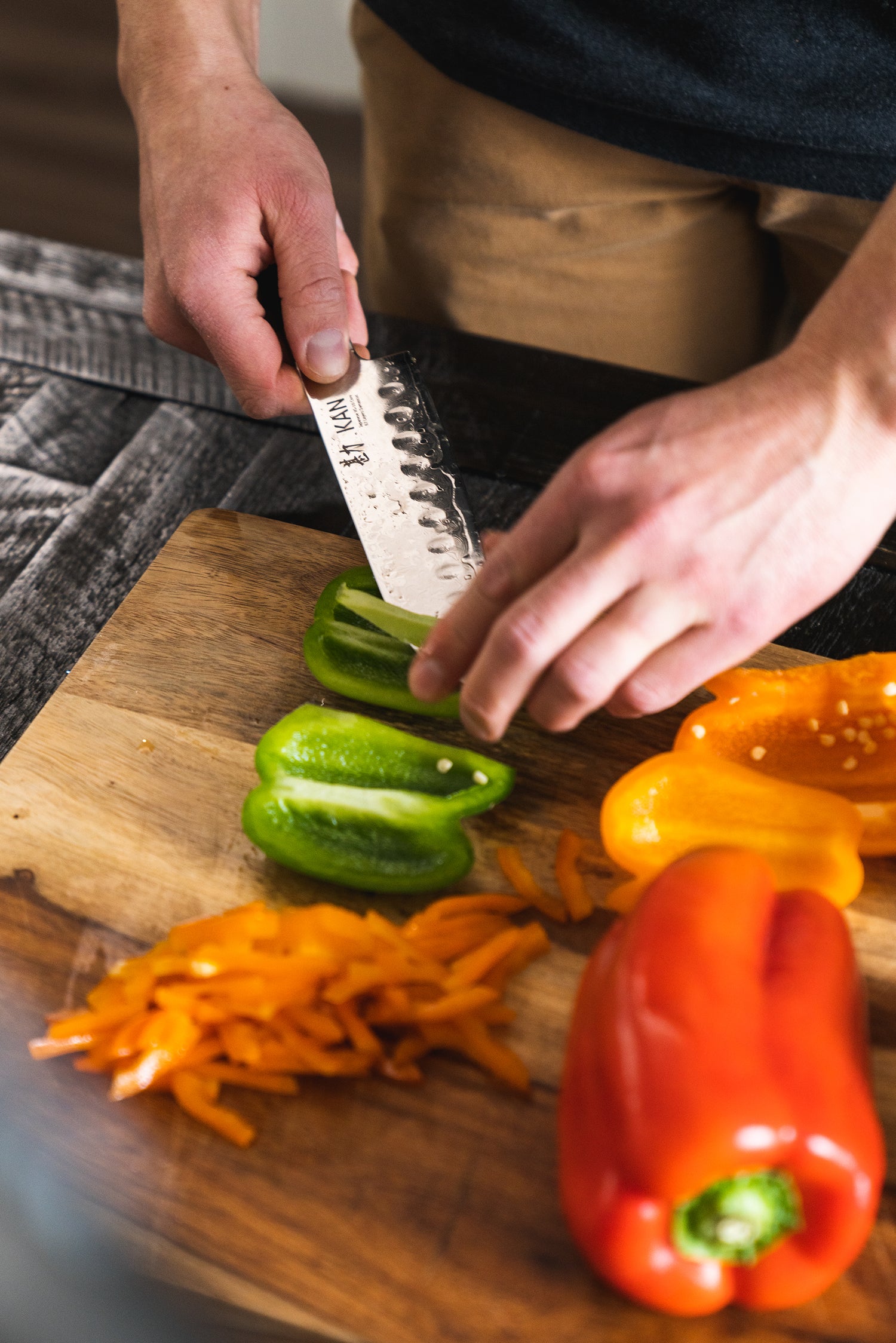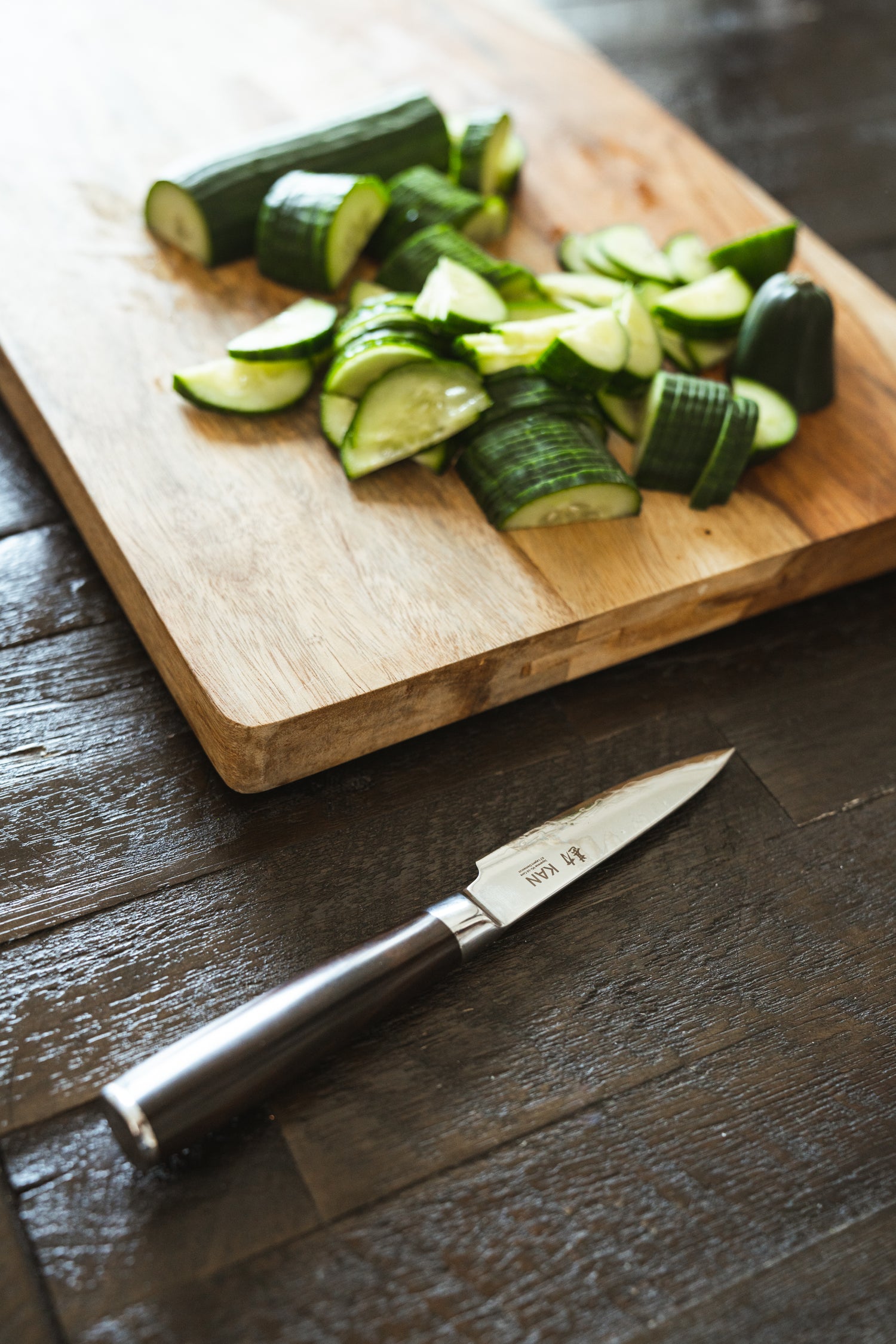
Note from the Owner
Welcome to the KAN Family,
Congratulations on your new knife! As a quick note, I always love seeing what y'all make with your new knives, so please tag @kanknives on Instagram, and I'll try to respond. On a serious note, I wrote up a few important tips below of how to best use and care for these knives.
Missing any knives? I'm keeping all knives and sets on sale for the next little while.
Happy cooking!
Barney Lund
Owner
Before you start using your knife,
please follow some helpful tips from the pros:



Proper Use

Proper Use
Grip
We designed and balanced the KAN Core chef knife and santoku to encourage what is called a ‘pinch’ or ‘blade’ grip, shown here. You can use this grip on most all knives.
The benefits of the pinch grip over a common handle grip are:
- Improved stability/control
- Improved accuracy
- Decreased hand fatigue
It may feel strange or awkward at first, but please give the pinch grip a try; you may come to really enjoy it.

Proper Use
Cutting Surface
We worked very hard to attain the razor edge that is on your knife, straight out of the box. You can preserve that edge for a very long time if you follow a few guidelines.
Please never cut on extremely hard surfaces (granite, glass, ceramic, etc.). While a good-quality end-grain wood cutting board is definitely preferable, a plastic or bamboo cutting surface will be fine.

Proper Use
Bones & Frozen Foods
This one is simple. You now own a Ferrari of a knife. You wouldn’t take a Ferrari off-roading in the mountains and mud, right?
Your edge will last a very long time if you avoid using it to hack through bones or cut through unthawed ingredients.
Also, never pry open a container with your knife, both to avoid damage to the knife, and for your own safety.
Proper Care

Proper Care
Stay Clean
Clean
Soon after each use, clean your knife with warm water and mild soap, with a non-abrasive sponge or cloth. Never put your knife in a dishwasher.
Dry
Safely dry both the blade and handle thoroughly soon after washing.
Store
Avoid just throwing your knife into a drawer full of loose utensils, as you can damage your edge. We recommend using either a flocking-lined blade guard, a wooden saya, or a magnetic strip.
Oiling
With the ebony wood handle, it can be helpful to rub a few drops of mineral oil into the wood every now and then to avoid cracking, especially in very dry or changing climates.

Proper Care
Stay Safe
Three main things that will improve safety in the kitchen:
- Proper technique: We recommend a “claw” technique for the non-cutting hand, keeping the fingers curled back, with the thumb behind, completely out of the way. Walk the non-cutting hand back as you go.
- Proper storage: Again, never leave a very sharp knife in a sink, a cluttered drawer, or in the reach of children.
- Sharp edge: Dull is dangerous. Sharp is safe. It may be counterintuitive, but it’s true. Please keep your knife in good cutting condition. If you ever feel that you are having to force your knife through a food, please strop, hone, or sharpen the edge, as excessive force will lead to slipping/possible accidents.

Proper Care
Stay Sharp
Honing vs actual Sharpening
KAN Core knives can retain a very sharp edge for a very long time, if you treat it correctly. That said, you can take your edge (very lightly) to a honing rod. Honing is just straightening out an already-sharp edge, without removing material from your blade.
Sharpening, on the other hand, is where you actually remove material from the cutting edge, to make it thinner (thus sharper). Eventually after use, all blades will require sharpening.
Japanese Water Stones
You don’t have to break the bank buying sharpening stones. Maybe start with something like a 1000 grit stone (lower number = coarser grit), practice up, and sharpen as often as you need to.
We really like this option, because you’ll probably eventually want to know how to do this, and you can literally get a hair-popping edge on your own with a fairly inexpensive stone. It doesn’t take long to get started, and many people enjoy it so much, it becomes a new hobby!

Honing Steel
If you insist on use a honing rod, please use very little pressure. Too much pressure could chip or otherwise damage your blade’s edge.
Check out our quick sharpening video with Kenji:

KAN Kitchen
KAN Core Complete Set
Share

FAQs
I want to tell my cooking enthusiast friend what I just got. What can I say?
Your KAN Core Knife has the following main attributes:
- Japanese VG-10 steel core, clad with 66 layers of stainless steel
- Ambidextrous handle with ebony wood or G10 composite resin
- We put a 15-degree, double-beveled edge on most of our knives (not on the steak, boning, or bread knives)
- You may have chosen a hammered finish, in which case, you have an added feature that not only looks good, but helps with food release, too.
- Hardness of approximately 60 on the Rockwell hardness scale (60 HRC)
- Combination between a traditional Japanese and a European-style blade and handle shape, allowing for rocking, chopping, slicing, and even coring
- J. Kenji Lopez-Alt gave your knife the stamp of approval and uses it in his own kitchen (if you’re not familiar with Kenji’s work, do yourself a favor and at least check out his home cooking show on YouTube)
Are KAN Core knives dishwasher safe?
No. We can’t emphasize this enough. Never put your KAN Core knife in a dishwasher. Harsh detergents can pit a blade over time. Knocking around against other utensils can damage your edge. Sustained high temperatures can affect the heat treatment of your knife. Please hand wash and dry immediately, and your knives will love you forever for it.
What do you suggest for sharpening/honing?
If you hone, do it very lightly. You can also use a leather strop in place of a honing rod. As for actual sharpening, some people could maybe go six months before needing to sharpen.
There are three or four ways you could sharpen your knife.
- Japanese Water Stones – Start with a Japanese water stone (something like a 1000 grit), practice up, and sharpen as often as you’d like. We really like this option, because you’ll probably eventually want to know how to do this, and you can literally get a hair-popping edge with an inexpensive stone, on your own. It doesn’t take long to get started, and many people find it soothing enough to become a true hobby.
- Professional Bladesmith – Many cutlery shops will sharpen your knives for a reasonable fee, so if you don’t feel like learning, find someone who has already mastered the skill.
- Electric Sharpeners – Please heed this warning: you will probably get what you pay for with an electric sharpener. Truly, we can’t whole-heartedly support using an electric sharpener, as most of these will remove unreasonable amounts of metal from your edge and can drastically affect the geometry of your blade in short order.
- Other methods – There are some very fancy (and very expensive) methods of getting a very fine edge on your knife. Some are complicated contraptions, but really create the perfect stone-to-edge angles, taking razor-sharpness to the next level. Others will use belts that can put a convex edge on your knife. Please don’t use any method that would change the profile and geometry of your knife if you aren’t confident in your skills. Again, we highly recommend trying your hand with a sharpening stone or two.
Where can I get more?
Authentic KAN Core knives are currently only sold on our website and on Amazon. As for other knife types, please stay tuned and subscribe to our newsletter below, as we are designing and coming out with even more knives and accessories shortly.
Enjoy, and stay sharp!
" When you acknowledge, as you must, that there is no such thing as perfect food, only the idea of it, then the real purpose of striving toward perfection becomes clear: to make people happy, that is what cooking is all about."
– Thomas Keller
